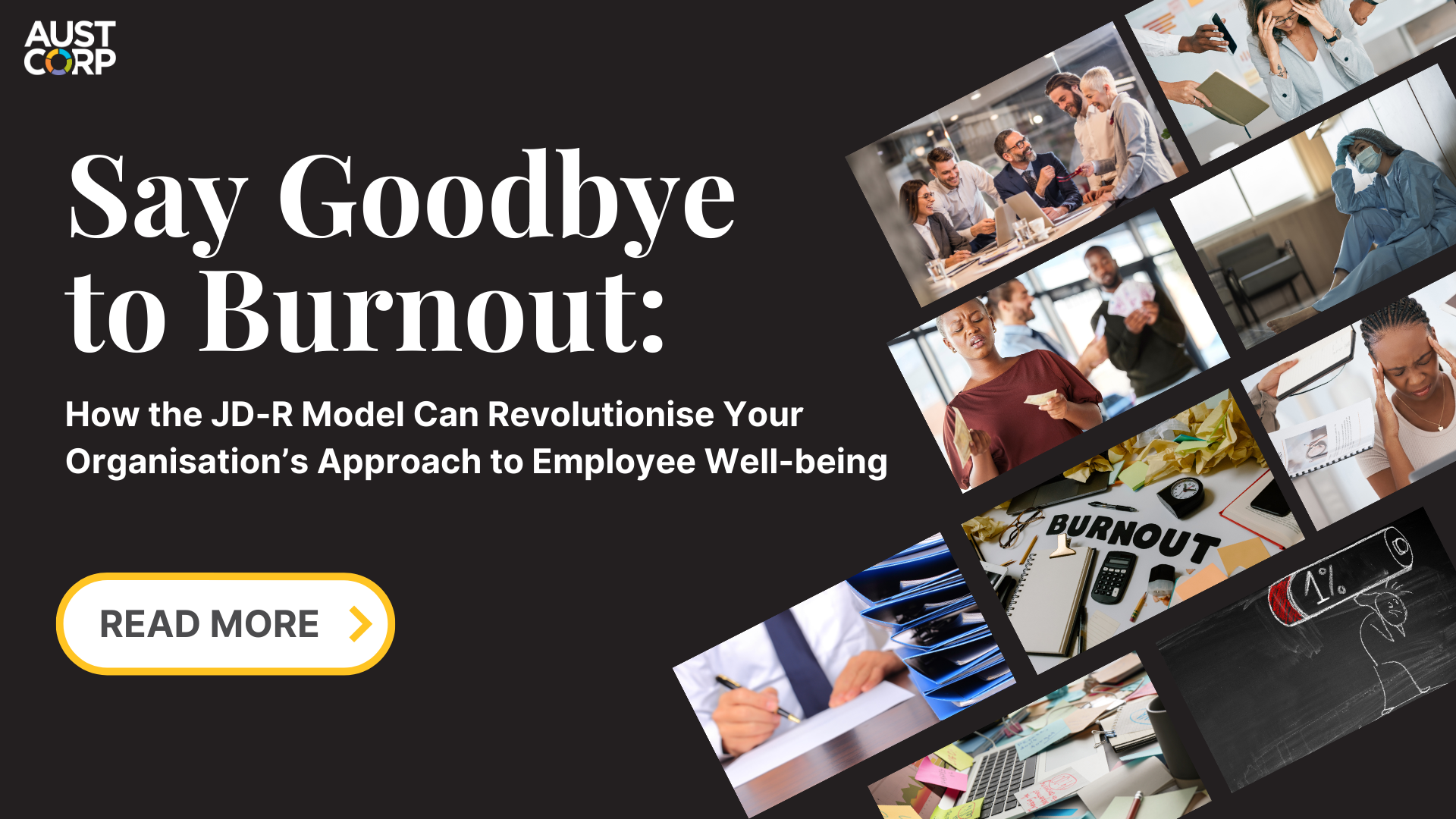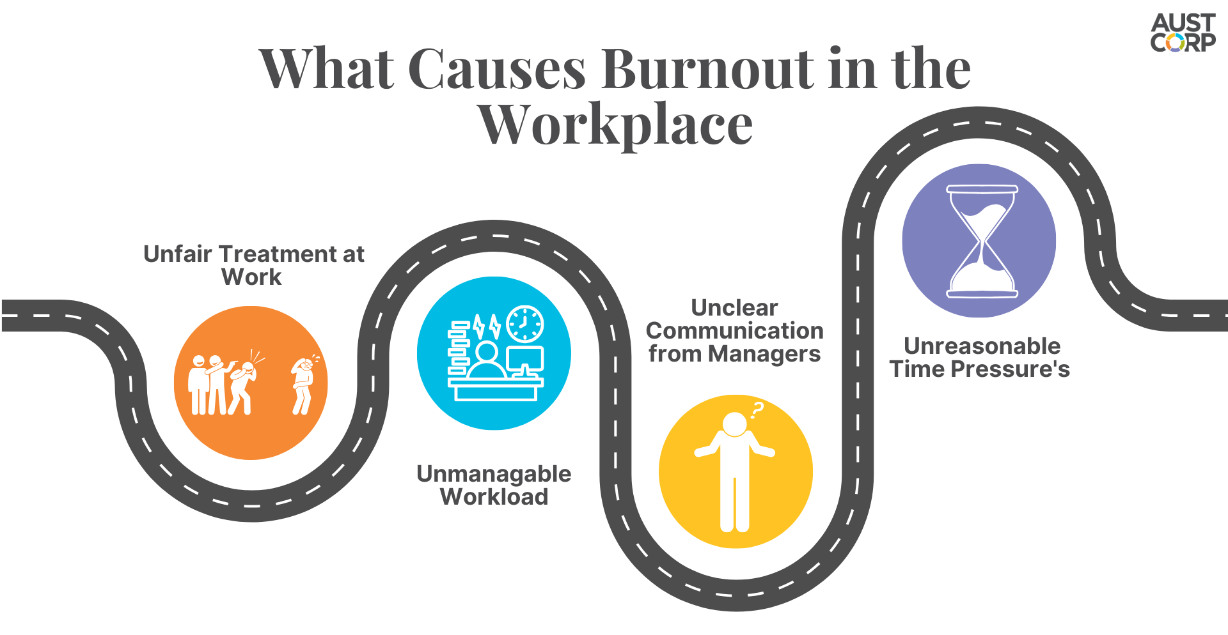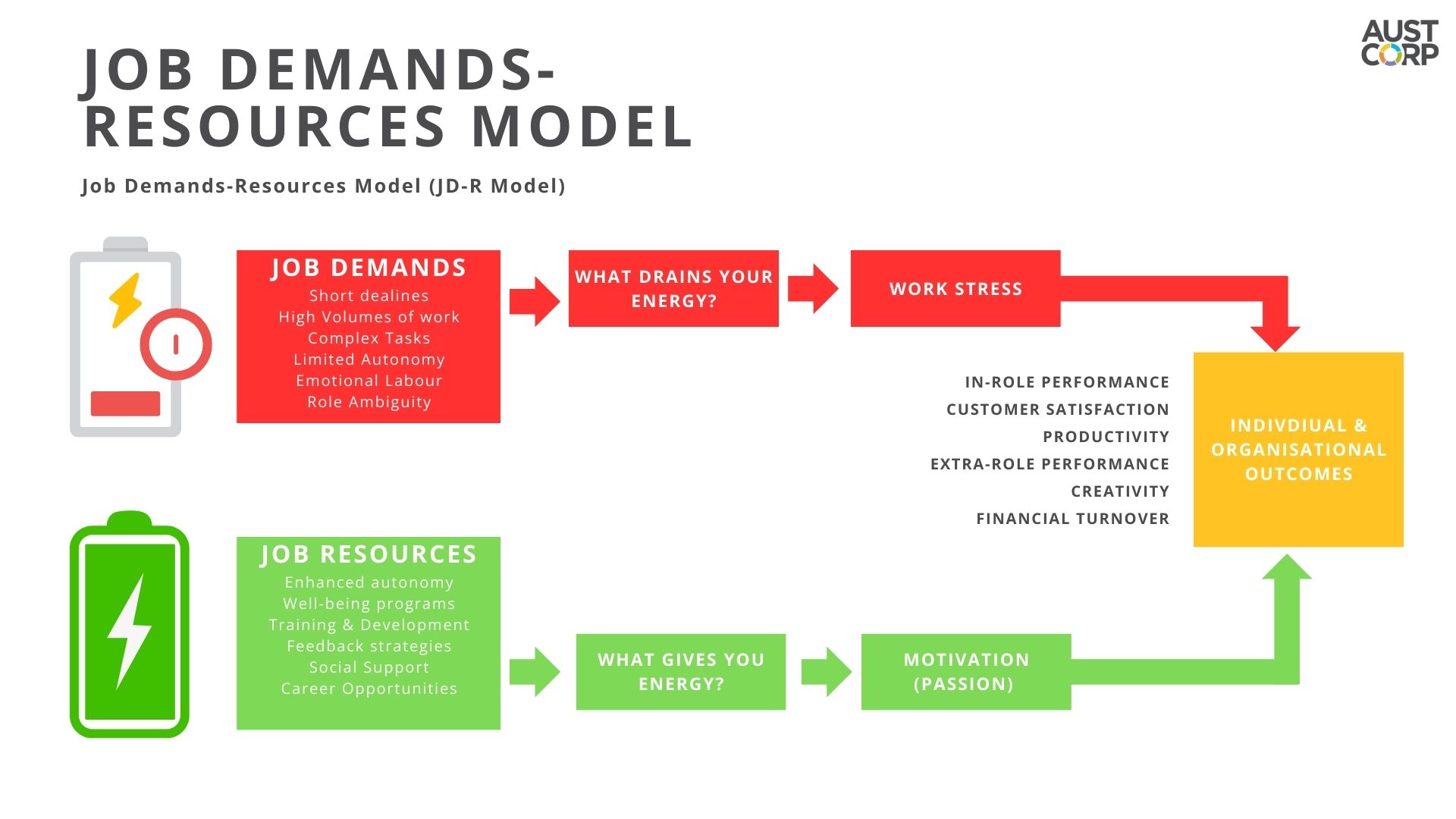.png)
Say Goodbye to Burnout: Utilising the JD-R Model to transform your Employee's Well-being
Heavy workloads and looming deadlines are unavoidable parts of managerial responsibilities. It's natural to feel occasional stress, but when relentless work pressure leads to burnout, it becomes a severe issue. Burnout can negatively impact one's performance, well-being, and the effectiveness of one's team and organisation.
What Is Workplace Burnout?
The pressure to address job burnout became so intense in 2019 that the World Health Organization declared burnout an occupational phenomenon in the 11th revision of the International Classification of Diseases.
The World Health Organization defines burnout as "a syndrome conceptualised as resulting from chronic workplace stress that has not been successfully managed."
What Are the Symptoms and Signs of Burnout?
According to the World Health Organization, signs of burnout at work include people feeling:
depleted or exhausted
mentally distant from their job or negative feelings or cynicism about their job
reduced professional efficacy
Work burnout diminishes employees' desires to learn and grow. When employees experience these symptoms, most of their energy and mental focus is on daily survival, not developing for the future.
What Causes Burnout?
There is little doubt that employee burnout is a symptom of modern workplaces that are increasingly fast-paced, complex, and demanding. At work, many employees feel overwhelmed by competing demands and conflicting expectations. Technology—especially mobile technology—has blurred the lines between home and work life.

Unfair Treatment at Work:
When employees strongly agree that they are often mistreated at work, they are more likely to experience high burnout. Unfair treatment can include workplace issues, from bias, favouritism and mistreatment by a coworker to inconsistently applied compensation or corporate policies.
When employees do not trust their manager, teammates, or executive leadership, the psychological bond that makes work meaningful breaks; conversely, when employees are treated fairly and respected, strong relationships form quickly, and employees are more resilient.
Unmanageable workload:
Employees who strongly agree that they always have too much to do are likelier to say they often experience burnout or are always at work.
Even high-performing employees can quickly shift from optimistic to hopeless when they struggle with unmanageable performance goals and expectations due to a lack of workload management.
Feeling overworked or having too much to do can take various forms. Some people think about the long hours they work, while others are more affected by the many tasks they have to complete or the difficulty of the work.
However, how people experience their workload has a more substantial influence on stress and burnout. For instance, engaged employees with job flexibility tend to work more hours each week than the average employee while reporting higher well-being.
But when work feels burdensome, challenging to do well or endless, employees can feel suffocated, regardless of how few or many hours they work.
Unclear communications from managers:
When managers provide employees with the information they need to do their jobs effectively, work becomes more accessible and manageable.
On the contrast, when performance expectations and accountability are not consistent or clear, employees can become frustrated and exhausted by trying to figure out what their manager wants from them.
The best managers regularly discuss responsibilities, priorities, performance goals, and expectations with their employees and collaborate with their team members to ensure that expectations are clear and aligned with team goals.
Great managers proactively share information, ask questions and encourage employees to share their thoughts.
Unreasonable time pressure:
Unreasonable deadlines and pressure can create a snowball effect: Employees who miss one overly aggressive deadline stay caught up on the next thing they are scheduled to do.
Notably, individuals handle time pressure differently. Employees naturally fit for a role tend to work more efficiently and sustain high performance for extended periods.
They also have more positive daily work experiences and handle stress more effectively under pressure than employees who do not naturally fit.
Leaders must ensure that their role expectations and performance standards are fair and inspire excellence. And when employees step up to work overtime or accomplish tasks under tight deadlines, leaders should recognise their willingness to go the extra mile.
Why Do You Need to Worry About Employee Burnout?
Burnout is not just an inconvenience—poor well-being affects your organisation's bottom line through lower productivity, higher turnover, higher absenteeism, and higher medical costs (due to preventable conditions). On average, burnout can cost organisations 15% to 20% of total payroll in voluntary turnover costs.
The long-term effects of individual employees experiencing burnout are that they take more sick days, feel less confident in their performance, and are more likely to actively seek another job. Thriving employees fuel a thriving workplace, and your organisation can suffer when employees are struggling, experiencing negative emotions, or feeling burned out.
The JD-R Model: A Practical and Effective Framework for Managing Burnout
The JD-R Model offers hope in today's complex corporate environment, where balancing high performance and employee well-being is a constant challenge. This model provides
A structured approach to balancing job demands and resources,
Addressing the root causes of burnout and
Fostering a healthier, more productive workforce.
The JD-R model's structured approach to managing job demands and enhancing resources makes it a valuable tool for mitigating burnout and creating a healthy, sustainable work environment.
What is the JD-R Model?
The Job Demands-Resources (JD-R) Model is a framework that encourages employee well-being. Managers and supervisors use it to manage employee involvement. The work stress model suggests that stress arises from the imbalance between the job requirements and the resources the employee has available to meet those requirements.
A central proposition in the JD-R theory is that although employees work in various sectors, their job characteristics can be classified into Job Demands and Resources.
Job Demands: These are the aspects of the job that require physical as well as emotional effort of the employee and are associated with physiological and psychosocial costs. The job demand consists of:
Qualitative job Demands include emotional, mental, and physical demands.
Quantitative Job demands: work overload, work underload, pace of change
Organisational demands: Negative demand, harassment, role conflicts, interpersonal conflicts.
Job Resources: Job resources are aspects of the job that support and facilitate employees in doing their jobs; this also helps employees reduce job demands and stimulate personal growth. Example include:
Social Resources: Co-worker support, supervisor support, team atmosphere, effectiveness, role clarity and recognition.
Work resources: job control, person-job fit, task variety, use of skills.
Organisational resources: Communication, Alignment, Trust in leadership, fair pay.
Development resources: Performance feedback, possibilities for learning and development and career perspective
Energy Processes: The proposed models demonstrate that employee energy is the central mechanism linking job resources, demands, and outcomes. As job responsibilities increase, employees must invest their energy in handling heavier workloads, time pressure, and challenging goals. Organisations should consider this to assist employees in meeting job demands and provide the necessary resources to replenish their energy.
Outcomes: The JD-R model predicts that employees' outcomes depend on their balance between job resources and job demands; providing ample job resources with proper clarity in job demands will yield positive job outcomes, while not providing them will yield adverse outcomes and burnout.
Positive Outcomes include improved employee work productivity, increased employee engagement, job satisfaction and low employee turnover.
Adverse outcomes include burnout, employee health issues, and lower job performance.

How to use the JD-R Model?
Follow these steps if you want to apply the JD-R model effectively.

Identifying Job Demands
Start by analysing the job demands and requirements of that position and identify all the negative stressors and the physical, psychological, and organisational aspects of a job. Examples of these are:
Project Deadlines
Work pressure
The high volume of work
Uncomfortable work environment
Poor leadership
Unclear goals and objectives
Company politics
Emotionally draining task and role
No learning and development opportunity
Limited opportunity for growth
Addressing Job Demands
After making a list of all the factors that have negative consequences in the workplace, review them to understand the causes and assess if you can make any changes. For example, if an employee is dissatisfied with their work due to repetitive tasks and unchallenging work, you could reassign them to a new role and look for a department that needs a new perspective.
Similarly, organisations can engage with every department and team to understand their concerns and problems and what to do for new joiners. This helps identify the company's communication problems and address issues related to a lack of structure in the workplace.
Below are some common examples of changes you can make to address these job demands:
Defining roles and objectives helps team members understand the definition of success and how to accomplish it, reducing stress and minimising the risk of burnout. Being clear about goals also includes recognising that it is acceptable and beneficial to disconnect and recharge once daily objectives have been achieved, significantly reducing the likelihood of burnout.
Streamlining workflows: Improving workflows involves optimising and simplifying processes to boost efficiency and productivity in the workplace. This can be accomplished by identifying and eliminating redundant tasks, automating repetitive processes, and ensuring clear communication channels. Employers can introduce project management software such as Asana or Trello to track assignments and deadlines, ensuring everyone is aligned and aware of their responsibilities. Regular process audits can also help pinpoint bottlenecks and areas for improvement. Ensure that training is conducted for employees on best practices and using new tools to enhance their ability to work effectively.
Fostering a culture of open communication and transparency: First and foremost, communication channels must be robust and transparent. A leader's willingness to listen can be as crucial as their ability to guide. Leaders can identify potential burnout triggers early by fostering an environment where team members feel comfortable sharing their concerns and challenges. This means more than maintaining an open-door policy; it means actively contacting and checking in with team members. It's about creating a culture where the line between professional and personal well-being is acknowledged and respected.
Prioritise and delegate tasks: Identify critical priorities and align tasks accordingly. Leaders must delegate responsibilities based on their team members' strengths and capacities. This encourages a more manageable workload and allows employees to focus on what they do best, reducing overwhelming feelings.
Set Realistic Deadlines: When setting deadlines, consider the complexity of the task and team members' existing workloads. Unrealistic time pressures can lead to stress, which may compromise the quality of work. Open discussions about what is achievable within a given timeframe can lead to more realistic deadlines and a reduction in overload.
Encourage Regular Breaks: It may seem counterintuitive, but short breaks can significantly improve productivity. Encourage your team to step away from their desks, walk, or engage in other restful activities. This helps refresh the mind and can lead to more efficient work output.
Identifying Possible Job Resources/Positives
This step involves recognising what resources are currently available and what additional resources may be needed to help employees manage job demands and foster personal growth.
Determine the job resources or positives that can help employees find fulfilment and feel motivated, passionate, and committed, acting as buffers to job demands. These resources could include:
Enhanced Autonomy: Enhancing autonomy in the workplace involves empowering employees to take ownership of their tasks and make decisions independently, which can lead to increased job satisfaction and productivity. This can be achieved by:
Provide clear goals and expectations but allow employees the flexibility to determine how they achieve them.
Encouraging self-directed projects and providing opportunities for professional development.
Implementing flexible work hours or remote work opportunities can give employees more control over their schedules.
Trusting employees to manage their workloads and offering support when needed, rather than micromanaging.
Creating a culture that values innovation and independent problem-solving.
Facilitating Supportive relationships: Encourage strong work relationships and teamwork through social activities and team-building exercises. Regular team outings, such as group lunches, happy hours, or recreational sports, provide an informal setting for employees to bond and build rapport outside of the office environment. Structured team-building exercises, like collaborative workshops or volunteer events, can improve communication, trust, and collaboration among team members. Employers can also encourage cross-departmental projects or mentorship programs to facilitate connections between employees who may not typically interact.
Flexibility in work arrangements: Adaptability also plays a pivotal role. While the traditional 9-to-5 model applies in many scenarios, it might only suit some. Recognising this, leaders can explore flexible working hours, remote options, or job-sharing schemes. These alternatives accommodate team members' diverse life circumstances and preferences and signal trust—a potent antidote to burnout.
Promotion of Work-life balance: Leaders should also embody the work-life balance they advocate. It's challenging for team members to feel justified in taking time for themselves if they see their leaders perpetually overworked and unavailable. By setting an example—taking regular breaks, prioritising time, or openly discussing their methods for managing stress—leaders can legitimise the pursuit of balance within their teams.
Improving Work Conditions: Provide a comfortable work environment and remove any physical or logistical barriers hindering productivity. This might involve introducing ergonomic office setups with adjustable chairs and desks, which can alleviate physical strain whilst ensuring lighting is conducive to comfort and concentration. You can also introduce quiet zones or relaxation areas where employees can take short breaks.
Well-being programs: Investing in wellness programs signifies a commitment to employee health. From fitness memberships to mental health support, these initiatives show that the organisation cares about its employees' well-being, fostering loyalty and enhancing overall performance.
Celebrate achievements and provide feedback: Consistent and constructive feedback and recognition of employee accomplishments are critical motivators. They reassure employees of their value to the organisation and reinforce personalised contributions, thereby sustaining higher performance for members without the adverse effects of overload. Constructive feedback also plays a crucial role in personal and professional development, enabling employees to grow and improve their performance without feeling overloaded.
Investing in Training & Development: Finally, investing in professional development and career growth can significantly mitigate feelings of stagnation and frustration, which often contribute to burnout. Leaders can craft personalised paths by identifying and nurturing each team member's strengths and ambitions. Encorganisationm to pursue additional training, attend conferences, or take on challenging projects can reignite passion and a sense of purpose. Training sessions on time management, stress management, and effective communication can also equip your team with the tools to perform optimally without feeling overwhelmed.
Promoting Your Job Resources
When you have the resources ready, the next step is to implement and actively support the identified resources to ensure they are accessible and utilised by employees.
Actions needed:
Implementation: Roll out the identified resources, ensuring they are integrated into the organisational processes and accessible to all employees.
Communication: Communicate the availability and benefits of these resources to employees, ensuring they understand how to access and use them.
Support: Provide ongoing support to employees to encourage their use of these resources, such as training sessions, informational resources, and dedicated contact points.
Evaluation: Continuously monitor and evaluate the effectiveness of the promoted resources, gathering feedback and adjusting as necessary.
Conclusion
In conclusion, addressing burnout is not just a matter of individual well-being—it's a crucial strategy for organisational effectiveness and sustainability. With heavy workloads and looming deadlines becoming an unavoidable part of managerial responsibilities, the threat of burnout looms large. As we have explored, burnout impacts the individual and the overall performance and health of teams and organisations. The adverse physical and mental health consequences of burnout underscore the need for well-designed and efficient workforce management strategies.
The JD-R Model offers a practical and effective framework for managing burnout by balancing job demands and resources. Organisations can mitigate the risks of burnout by identifying and addressing job demands, providing adequate resources, and fostering a supportive and flexible work environment. The model's structured approach helps create a healthier, more productive workforce, ensuring employees are engaged, motivated, and satisfied.
Implementing clear role definitions, streamlined workflows, open communication, realistic deadlines, regular breaks, improved work conditions, and well-being programs can significantly reduce burnout. Additionally, enhancing autonomy, facilitating supportive relationships, and investing in training and development are essential to promoting a positive work environment.
At AustCorp Executive, we specialise in recruitment and workforce management solutions. With over 27 years of experience, we understand organisations' challenges with high turnover rates, absenteeism, and burnout. Our expertise lies in helping organisations like yours build effective strategies to create thriving workplaces. We are dedicated to aligning talent with opportunities, ensuring your organisation and employees prosper.
Ready to transform your approach to employee well-being and create a resilient workplace? Contact AustCorp Executive today to discover how our recruitment and workforce management solutions can support your HR needs, provide the relief you need, and help you foster a positive, productive, and engaged workforce. With us, you can be confident that you're making the right choice for your organisation.
